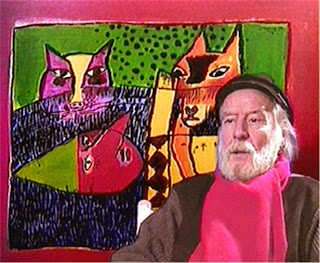You need:
- white drawing paper A3 size
- tempera paint
- brushes
- paper towels
- jar with water
- coloured paper for background
- glue or stapler
Life and work of Corneille
Guillaume Cornelis Beverloo (1922 - 2010), Corneille, was a Dutch artist,
.jpg)
born in Belgium and died in France. He is buried on the same cemetery as Vincent van Gogh, a painter he highly admired .
Corneille was an autodidact. In his early years he painted realistic: still lifes, people and landscapes. In 1948 Corneille was involved in the creation of the CoBrA Group, a group of Danish (Copenhagen), Belgian (Brussels) and Dutch (Amsterdam) artists. Even writers and poets belong to the CoBrA group. The artists' group only existed for three years, but has been very important for Corneille's work.
According to Corneille, the CoBRA artists want to express themselves on a expressionistic way, like children, by playing open-minded with colours and shapes.
Since 1950 Corneille lived and worked in Paris. His paintings are bright and colourful. The sun, women, paradise, trees and birds are recurring elements. He is particularly fond of birds. His artist name Corneille is French for 'crow'.
What to do?
Show examples of Corneille's work. What subjects do you often see in his paintings? What do you notice about his style? Discuss the features: bright colours, thick black outlines, few details, painted as if it was made by a child, an image that sometimes is not complete (missing parts at the edges).
In this lesson students have to sketch very briefly (maximum 5 minutes!), to avoid drawing too many details and to force them to work big. Students may also choose to sketch with a small brush and light yellow paint. This will automatically result in working big with little details. The yellow lines can easily be painted with different colours later.
Sketching with yellow paint
Sketch the outline of a cat or bird and make sure this animal reaches at least three edges of the sheet: it should be big! Paint the animal in bright colours and/or patterns. Paint the background too. Leave the work to dry and outline everything using a small brush and black paint. Paint your name in black somewhere at the artwork, like Corneille did. Stick the painting on a coloured sheet.
All artworks made by students of 11 years old

.jpg)
.jpg)
.jpg)
.jpg)
.jpg)
.jpg)
.jpg)
.jpg)
.jpg)
.jpg)
.jpg)
.jpg)
.jpg)
.jpg)

.jpg)
.jpg)
.jpg)
.jpg)
.jpg)
.jpg)
.jpg)
